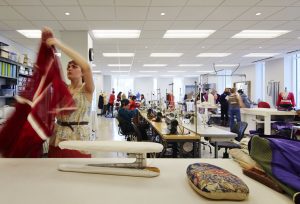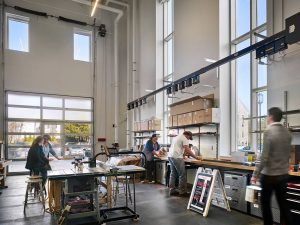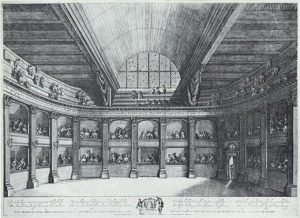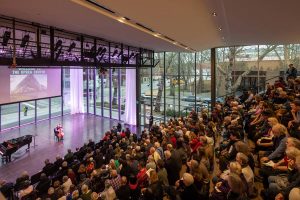Let the Sunshine In – Daylight in Performing Arts Buildings
What is the Number One issue that we hear from costumers when we plan new costume shops? Daylight.
We can’t have windows in “black box” studio theatres, can we? Yes, we can.
Is daylight beneficial in a scene shop? Definitely.
In a rehearsal room? Of course.
What does the National Association of Schools of Dance require for dance studios in program accreditation? Windows.
What about windows at grid level in a fly tower? Counter-intuitive, perhaps, but you get natural work light AND great views.
Since the advent of electrical lighting and HVAC systems, performance facility designers have often buttoned up our performance buildings, leaving only the public lobby as the iconic, glass “lantern” that beckons audience members toward the front of the building while the rest of the building exterior remains relatively impenetrable. Acoustical concerns, traditional theatrical aversions to daylight, and the inevitable value engineering exercises are often at odds with the desire for more windows and therefore more sunlight in our performance buildings.
According to the Illuminating Engineering Society’s Recommended Practice for Daylighting Buildings, “Daylighted buildings offer significant benefits that include visual and thermal comfort, occupant satisfaction, a connection to the outdoor environment, and reduced energy consumption, maintenance costs, and greenhouse gas emissions.”
Introducing daylight into workspaces during routine workdays has been shown to increase worker satisfaction as well as productivity. In the performance world, technical and design staff often keep long working hours. It is not unusual for the creative staff and performers to arrive at work in the dark and leave long after the light has faded, especially during the shorter winter daylight hours. Imagine the difference during work calls or load-ins when natural light is introduced into these often cave-like stage and backstage spaces. And please, don’t bury the costume shop in a windowless basement. Costumers often log exceptionally long hours.

A busy university costume shop at DePaul University enjoys daylight. Costumers do not want to be stuck in the basement. Photo provided by Schuler Shook.
Daylight provides more full-spectrum light that any electric light source. While some costume, make-up and set and prop painting situations benefit from a lighting environment that simulates theatrical lighting color temperatures and spectrums, most shop staffs appreciate having access to and control of both natural and stage lighting options. Costumers, make-up artists, and painters will benefit from and appreciate natural lighting as opposed to exclusively artificial lighting.
While performance facility designers are increasingly more comfortable and adept at introducing natural light into our performance facilities, windows and daylight have been included more conventionally in the design of concert halls and other music performance spaces. Theatre and dance venues, where it is important to control the interior environment for theatrical lighting effects, require durable blackout shades, heavy theatrical curtains, or hinged closure panels. Daylight is a benefit in all types of performing arts buildings, even if it is not employed during performance conditions.

The scene shop with daylight at Hobart and William Smith Colleges makes for a more pleasant place to work. Photo by Halkin-Mason Photography, courtesy of Theatre Consultants Collaborative.
The location of windows is important. Windows in scene shops should be clerestory or high on the walls so as not to restrict valuable storage locations and tool usage. Floor to ceiling windows in certain rehearsal and dance studios can be wonderful, especially if there is a compelling view either into the room or out to the world beyond, but it is equally important to understand that some performers also require a varying degree of visual privacy during rehearsal and warm-up.
A green room or performer lounge will benefit from natural light while privacy is maintained. Dressing rooms also demand visual privacy and are less likely to benefit from a conventional window. Of course, if a space has an opportunity to enjoy an exquisite view, take that opportunity and provide adequate visual and light control. Instrumental and choral rehearsal rooms are enhanced by access to abundant natural lighting.
“Out, out brief candle”. The theatrical metaphor is powerful. It is interesting to consider that we have been celebrating and performing the plays of William Shakespeare for well over 400 years. Shakespeare’s plays were all originally performed in broad daylight. Borrowing a more recent theatrical expression, "Let the sunshine in."
By Robert Long, FASTC
Robert Shook, FASTC
Disclaimer: Any views or opinions expressed in these articles are solely those of the authors and do not necessarily represent those of the American Society of Theatre Consultants. These articles are for general information only and should not be substituted for specific advice from a Theatre Consultant, Code Consultant, or Design Professional, and may not be suitable for all situations nor in all locations.
More Light on the Subject

An image of the Schouwbourg Playhouse with a large window. Sadly the venue was replaced in 1665 with a larger building. Original engraving by Salomon Savery (1594 – c. 1678) / Public Domain (Creative Commons)
In 1637, architect Jacob Van Campen designed the Amsterdam Schouwbourg Theatre with a large arched window at the back of the balcony (front of the building) in order to capture afternoon sunlight that would fall on the actors’ faces as they faced the auditorium. Considering that indoor theatres and their respective lighting were in their infancy, this early attempt at “balcony front” stage lighting must have been pretty spectacular!
While we work hard today to isolate our auditoriums from exterior light spill, or rigorously control it, this seventeenth century attempt to overcome the inherent shadows from chandeliers and foot lights was no doubt a welcome asset.
By D. Andrew Gibbs, PhD, ASTC



